Invasion of the Tau Mutants: Bio Lab Research at RIC
- News & Events
- News
- Invasion of the Tau Mutants: Bio Lab Research at RIC
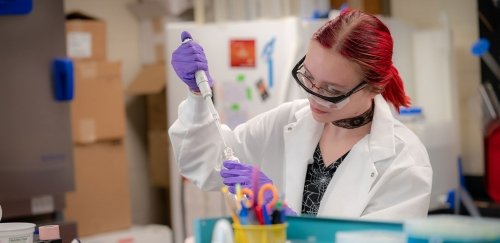
You’re not going to believe what biology students and their faculty mentors are cooking up in the lab these days ... Try mutant proteins.
Far from being an alien invasion, mutant proteins are errors in our own cells. Think of the nucleus of a cell as a cookbook. Inside the cookbook are chapters – chromosomes. Within each chromosome are genes – recipes for proteins. Sometimes the recipe calls for the wrong ingredients and the protein comes out malformed. It comes out as a mutation. Mutant proteins represent a problem with the recipe.
Biochemist Bill Holmes, an assistant professor of biology at Rhode Island College, is researching a mutant protein called “tau” found in the brain cells of people with neurodegenerative diseases like ALS, Alzheimer’s, Parkinson’s and Huntington’s.
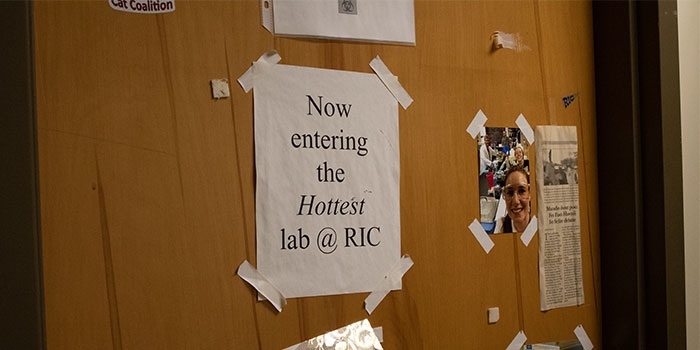
He and his student researchers want to know why tau proteins turn mutant. The word in the department is that Holmes has a busy lab. A good indication might be the signage on the outer door, which reads “Now entering the Hottest lab @ RIC.” Inside the lab, a work table is filled with labeled vials and flasks, beakers and solutions and scientific apparatus. In the corner is a desk with a computer where one of his six research students, Jess Anderson, is typing.
Anderson, who favors orange hair and skull t-shirts, could pass for a punk rocker. Actually, this very astute senior has presented her research at numerous scientific conferences and has aspirations of working in a forensics lab or as a microbiologist.
She swivels around in her seat to explain her research project. Basically, she says, everyone in the lab is attempting to unravel the mystery of “tau misfolding and aggregation.”
If you’re an ordinary person and not a scientist, “tau misfolding and aggregation” registers like a foreign language requiring subtitles. However, Anderson’s lab mate, Matt Schiavo, is there to provide them. Also a senior, Schiavo has a brilliant aptitude for translating science-speak for nonscientists.
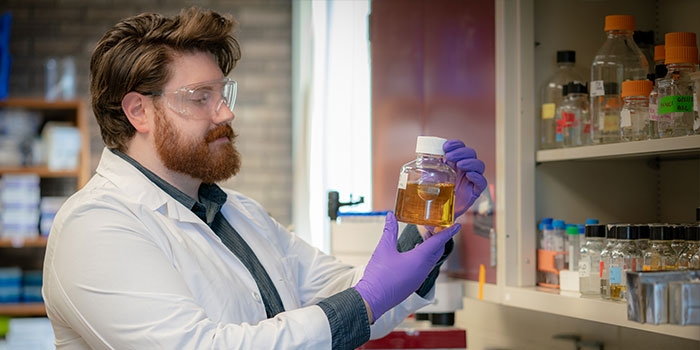
He says, “When proteins are made by our cells, they consist of a long string of amino acids that all have to fold into a specific 3-D shape in order to function properly. That folding happens with the aid of little chaperone proteins, little helpers, who help get that protein in the exact shape it needs to be to do its job. When the protein tau is healthy, it helps hold the cell in its proper shape, like scaffolding supports a building. When the protein misfolds it doesn’t get into the correct 3-D shape, which can cause the protein to stick together with other misfolded proteins, forming clumps. These clumps of misfolded proteins are called aggregates and it’s a common feature in neurodegenerative diseases.”
“So,” Anderson says, “in my particular project, I run experiments using baker’s yeast. I give the yeast the ability to produce the protein tau – meaning the normal, folded, healthy version of tau. And then I try to find what conditions I can manipulate to cause tau to misfold and aggregate/clump together. If those conditions are found, it would be the model for neurodegeneration.”
“If we can discover those conditions in yeast,” Schiavo underscores, “it’s possible that similar conditions may be at play in the neurons in our brains.”
He explains that yeast is a valuable asset to biochemists because the cells in yeast and the cells in humans have the same method of protein production and protein folding. Yeast is also cheaper and easier to come by than brain neurons if you need to run an experiment.
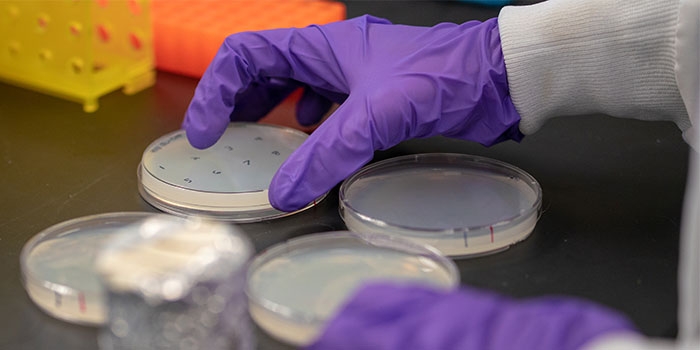
Approaching tau misfolding and aggregates from a slightly different angle, Schiavo’s project attempts to establish a molecular link (what we eat) to protein folding.
Schiavo came up with the idea to put the yeast on a low-carb diet and then to observe the effect on protein folding. He brought the idea to Holmes who found a way to integrate his research within the framework of the lab’s existing projects. Holmes fine-tuned Schiavo’s proposal, submitted it to the Rhode Island Foundation and was granted a $10,000 medical research grant to investigate the connection between metabolism (absorbing the nutrients we eat) and protein health.
“It’s a very new field,” Schiavo explains. “Not a lot of work has been done yet on the molecular issues behind protein folding.”
The research students in this lab not only run experiments, they write scientific papers on their findings. Anderson has worked in Holmes’ lab for the past three years and has presented at RIC’s annual Center for Research and Creative Activity Poster Sessions and at the annual Rhode Island Summer Undergraduate Research Fellows (SURF) Conference at URI. She has also attended a scientific conference with Holmes on Alzheimer’s disease and a Protein Society Conference with Holmes, where she presented a poster.
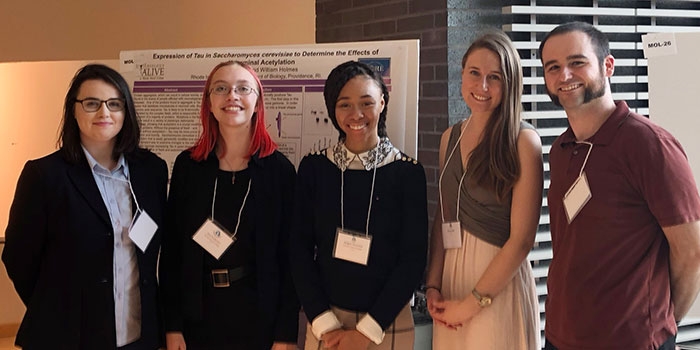
Schiavo, who wants to become an M.D., only began working in Holmes’ lab this summer, but both students speak with deep admiration for their mentor who seems to hold all of his students to a higher intellectual standard.
“Dr. Holmes treats us as if we’re real scientists, because in many respects we are,” Schiavo says. “He’s very hands-on in making sure you understand how to do a task, but then he takes off the training wheels right away. He wants you to learn to be independent and to do things on your own.”
“He does the same thing in his biochemistry classes,” Schiavo says. “If you can explain something, even if it’s wrong, and you can justify your reasons, he’ll give you some credit for it on your exam because you’re thinking like a scientist. He wants you to learn to work through problems. He’s truly an exceptional individual and an exceptional professor and mentor.”
RIC’s Department of Biology offers numerous opportunities for laboratory research, led by experts in their field like Holmes. Students benefit from experiential learning, they gain advanced-level lab skills that give them an edge on grad school or med school and they gain invaluable communication skills in writing and presenting their research findings at science conferences.
Click on Part 2, Part 3, Part 4 and Part 5 of this research series.
